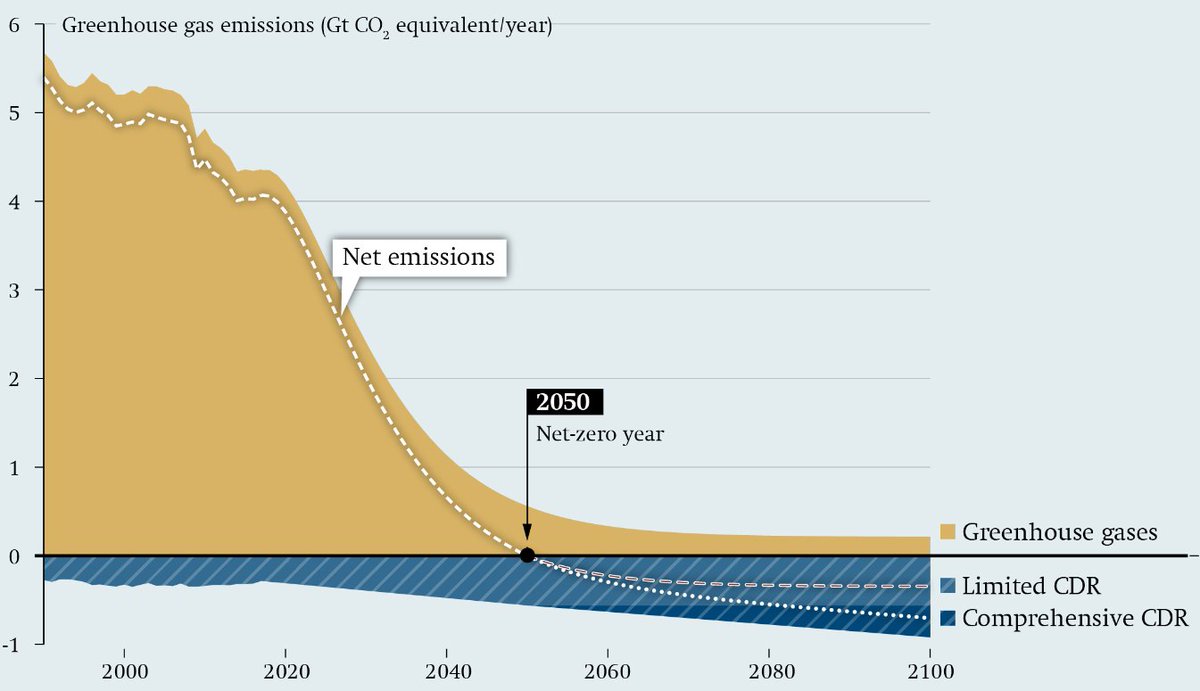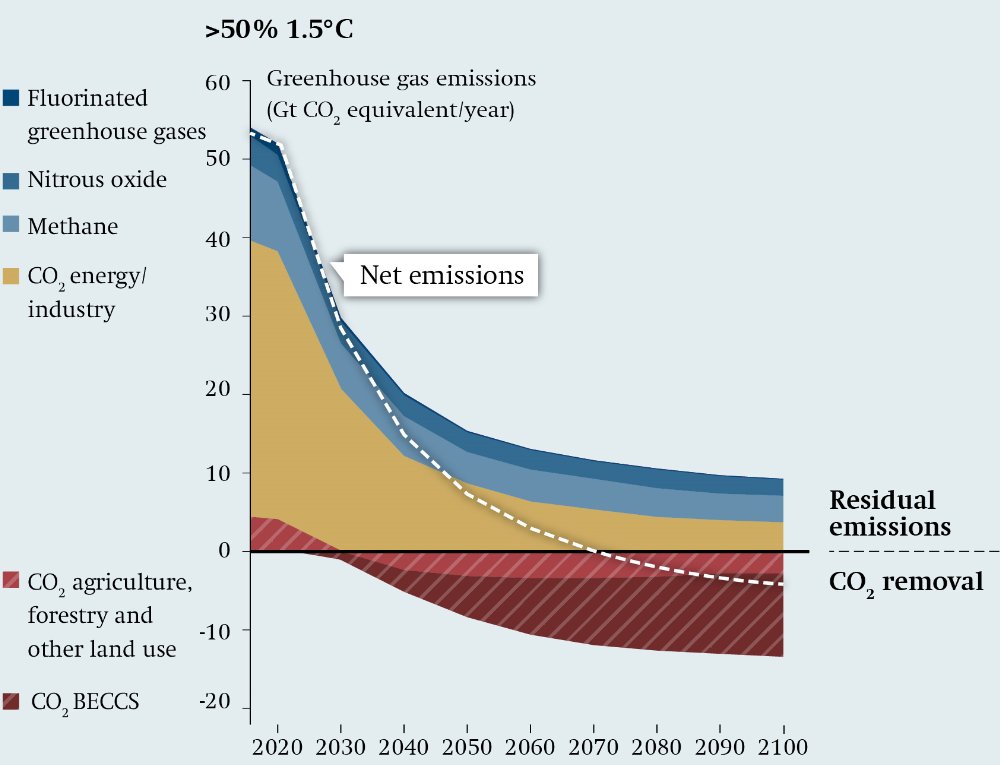"Unconventional Mitigation: Carbon Dioxide Removal as a New Approach in EU Climate Policy" - my new SWP Research Paper together with @FelixSchenuit
https://bit.ly/SWP20RP08
A Thread on why a #ClimateNeutralEU is impossible without CDR, and what the EU should do about it
(1/n)
https://bit.ly/SWP20RP08
A Thread on why a #ClimateNeutralEU is impossible without CDR, and what the EU should do about it
(1/n)
Trying to reach net zero emissions will lead to a certain level of residual ('hard to abate') emissions, which will need to be offset via CO2 removal options. This is an often overlooked aspect of global GHG mitigation pathways (below for 1.5C, according to #IPCC)
(2/n)
(2/n)
Since methane & nitrous oxide (mainly #agriculture) represent large share of residual emissions, scenarios achieve net zero GHG 15-20 years later than net zero CO2 (b/c of need for more CDR)
If you compare national GHG targets with global, 2067 is the benchmark, not 2050
(3/n)
If you compare national GHG targets with global, 2067 is the benchmark, not 2050
(3/n)
If EU wants to achieve net zero GHG by 2050, conventional mitigation measures to avoid emissions won't be enough.
To compensate for residual emissions, removing CO2 from the atmosphere will also be necessary, e.g. by afforestation or direct air capture (& storage) of CO2.
(4/n)
To compensate for residual emissions, removing CO2 from the atmosphere will also be necessary, e.g. by afforestation or direct air capture (& storage) of CO2.
(4/n)
With its 'net zero GHGs by 2050' target, the EU de facto already decided to use CDR at significant scales. That's why in our paper, we don't go that deep into technical details of CDR methods.
For more on that, see impressive work led by @MCC_Berlin https://iopscience.iop.org/article/10.1088/1748-9326/aabf9f
(5/n)
For more on that, see impressive work led by @MCC_Berlin https://iopscience.iop.org/article/10.1088/1748-9326/aabf9f
(5/n)
In the future, debate won't be whether EU should do deliberate CO2 removal or not. Main set of political questions will be: "Who does it? Which methods? Which volumes? By when?"
(btw: EU already does afforestation at significant scales (~300 Mt p.a., LULUCF sink ~250 Mt)
(6/n)
(btw: EU already does afforestation at significant scales (~300 Mt p.a., LULUCF sink ~250 Mt)
(6/n)
This is how 'new normal' will look like: residuals vs removals in the first net zero GHG year.
Political debate won't change much: industry will say residuals too low, NGO will say the opposite. Will it be the same for removals?
[below: @EU_Commission's net zero pathways]
(7/n)
Political debate won't change much: industry will say residuals too low, NGO will say the opposite. Will it be the same for removals?
[below: @EU_Commission's net zero pathways]
(7/n)
Political economy of integrating CDR is quite tricky
Not all member states (e.g. POL, IRL) & sectors (e.g. agriculture) will have achieved net zero GHG by 2050; some will already need to be below zero by then (SWE, FIN, power sector). CDR to raise new distributional issues
(8/n)
Not all member states (e.g. POL, IRL) & sectors (e.g. agriculture) will have achieved net zero GHG by 2050; some will already need to be below zero by then (SWE, FIN, power sector). CDR to raise new distributional issues
(8/n)
One 'latecomer' candidate for net zero GHG is Ireland, because of its very high share of #agriculture emissions (>30%). IRL will find it very hard to reach net zero by 2050, others (like POL) don't want to. Would publics in SWE/FIN/FRA/GER accept to go negative 'for them'?
(9/n)
(9/n)
Finally, some recommendations:
EU shouldn't allow any member state to reach net zero more than 10-15 yrs later than average. For sectors, such an obligation hard to establish, but they shd always be responsible for CO2 removals themselves (e.g., by buying removal credits)
(10/n)
EU shouldn't allow any member state to reach net zero more than 10-15 yrs later than average. For sectors, such an obligation hard to establish, but they shd always be responsible for CO2 removals themselves (e.g., by buying removal credits)
(10/n)
Avoiding GHG emissions should be given political priority over the subsequent removal of CO2. Net zero targets should be explicitly divided into emission reduction targets and removal targets (95:5, 90:10? else?), instead of simply offsetting effects of both approaches.
(11/n)
(11/n)
In coming years, EU should focus on investing more in research and development of CO2 removal methods and gaining more practical experience in their use. This is a question of adequate policy design, but EU shd start with strategic debate ahead of nitty-gritty regulation.
(12/n)
(12/n)
One crucial strategic question is how deeply EU wants to go 'net negative' after crossing 'net zero'. It'll influence the ramp-up speed & priorities in selection of CDR methods ('permanence issues'). Even keeping the CDR level of first net zero year won't be trivial at all
(13/n)
(13/n)
Find this and more in our new Research Paper "Unconventional Mitigation" http://bit.ly/SWP20RP08
And keep an eye on the news...
https://bioenergyinternational.com/heat-power/stockholm-exergi-to-be-climate-positive-as-early-as-2025
https://ec.europa.eu/clima/policies/innovation-fund_en (starting 3 July)
https://www.businessgreen.com/news/4017192/build-build-build-government-reveals-plan-direct-air-carbon-capture-funding-boost
(end)
And keep an eye on the news...
https://bioenergyinternational.com/heat-power/stockholm-exergi-to-be-climate-positive-as-early-as-2025
https://ec.europa.eu/clima/policies/innovation-fund_en (starting 3 July)
https://www.businessgreen.com/news/4017192/build-build-build-government-reveals-plan-direct-air-carbon-capture-funding-boost
(end)

 Read on Twitter
Read on Twitter





![This is how 'new normal' will look like: residuals vs removals in the first net zero GHG year.Political debate won't change much: industry will say residuals too low, NGO will say the opposite. Will it be the same for removals?[below: @EU_Commission's net zero pathways] (7/n) This is how 'new normal' will look like: residuals vs removals in the first net zero GHG year.Political debate won't change much: industry will say residuals too low, NGO will say the opposite. Will it be the same for removals?[below: @EU_Commission's net zero pathways] (7/n)](https://pbs.twimg.com/media/Eb1N1GEWAAUs23H.jpg)







